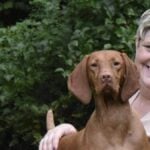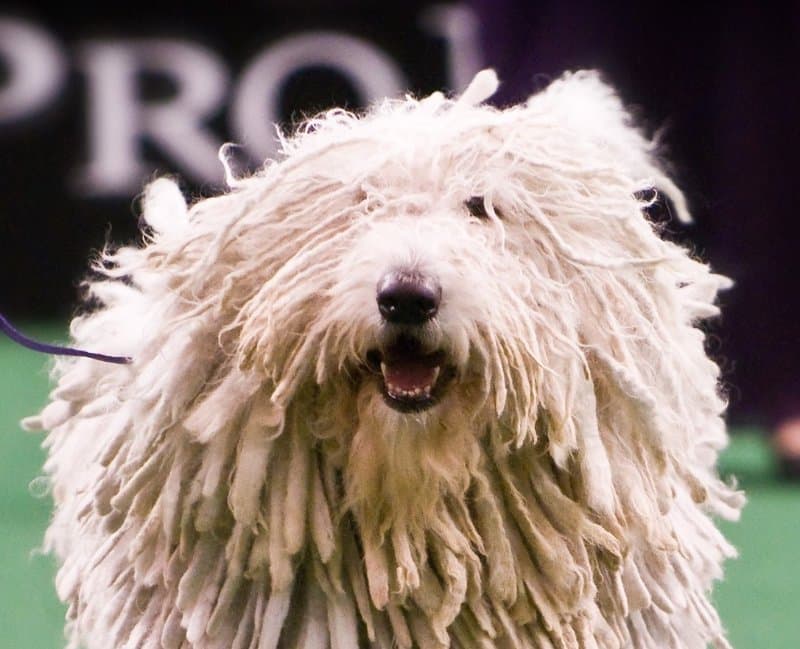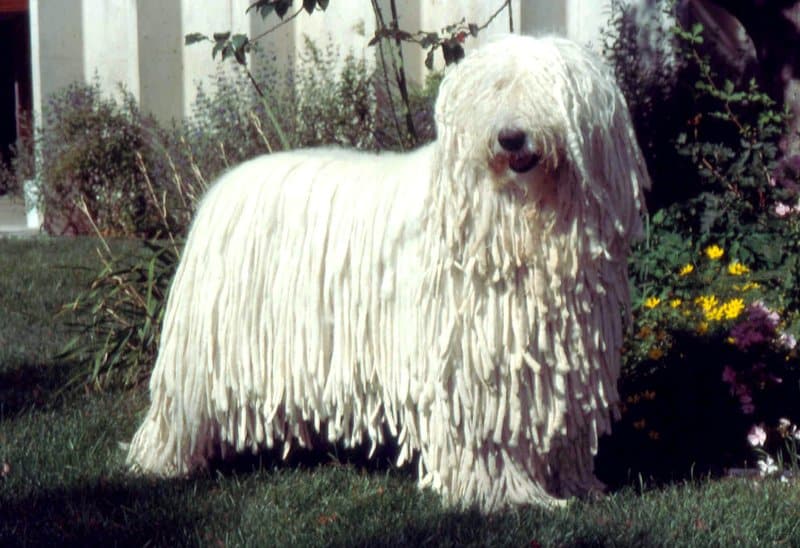
Home » Komondor Coats: Puppy to Maturity

Adult Komondors, well groomed, have amazing corded coats. There is no denying it. It looks good on TV at the big shows and is an attention-getter wherever they go. Really, the coat is a tool that protects the dogs from predators and from the weather when they are doing their flock guardian job. The coat is important, but we want our judges to evaluate the sturdy, athletic dog underneath the coat at all ages. The coat obscures the key aspects of the dog—differently at different ages.
[wonderplugin_3dcarousel id=66]
Komondors are not born corded. Babies have a dense coat with some crimp (or curl). There is often some cream color on the ears, which fades in a few months. We don’t brush or trim this coat. It just grows. Later, the cords will have soft tips; this is the original puppy coat. It is easier to see the dog under the coat now than it ever will be again.
By the time a Komondor might see the ring, at six months, much has changed. The 6-9 Puppy has several inches of fluffy puppy coat. Their neck has disappeared into the coat, their topline is entirely covered, and how much bone they have in legs and head can only be felt, not seen. Still, the properly presented Komondor puppy is not brushed or combed (except for maybe the feet and face). It is just a clean, tangled, ball of hair.
Evaluation of the dog under the coat must be done with the judge’s hands. Find the withers, feel the length of neck and the angle of shoulders from there, follow the shoulders down to the point of shoulder and prosternum, and then down to the elbows, to understand the front construction. The same is done to determine the length of rib cage, the shape of topline, and croup angle. The coat might feel a little matted at the base—that is OK.
Between nine months and a year, the cording is happening. It starts as clumping on the thighs or hips or whatever part they lay on. The “outside” of the coat may still just look like unbrushed hair, but at the base this is likely clumped or matted in plaits. The owners should start splitting the clumps and plaits into cords. Cords are the diameter of a quarter (coin) at the skin. The details of the manner and the speed of cord progress depends on how much curl and how much undercoat a particular dog has. Also, cording will be sped up by getting wet and drying out. So at this point, there is a lot of handwork in splitting the cords. Still, it is never brushed or combed.
By the time the dog is 15 months old or so, the coat is fully corded at the skin. Our “Failure of the coat to cord by two years of age…” disqualification is not very hard to achieve; most would pass by about one year. With cording, the dog has deflated a little and all that fluffy hair is compressed in the cords. While this is a perfectly proper coat for the age, many judges fault the dog on the move because the coat is flipping side-to-side over the topline.
It is wrong (but common) for a judge to fault a puppy for fluffy coat, a one-year-old for being partially corded, or an adolescent from 15 months on, for a year or so, for having a perfect coat for their age. In the same vein, judging Komondors by degree of cording or length of coat is not judging at all. The judge must always judge the dog under the coat, by proper movement, good angles, good bone, and proportion.
At about 2.5 years, the coat is long enough to not flip over the back on the move; the dog starts to gain the look of an adult Komondor. Now the coat just grows, 3-4 inches per year. The owner keeps splitting the cords at the skin and works hard to keep the dog from losing cords by the teeth of puppies, scratching, or any number of accidents. The dog needs to be kept from staining the coat because these cords have to last a lifetime in the show ring. Washing the adult is quite a production.
An hour or two in the tub, first soaping up and then completely rinsing the soap out of the coat. Sometimes we lay them down in the soapy water to soak during the bath. Sometimes a “bath” means soaping up and rinsing more than once. It would be so much easier if we could just zip off the coat and toss it into the washer and dryer! Drying takes a day or so, usually on towels or over a raised grate with big fans. Getting the dog properly rinsed and then dried is important to keeping them smelling good.
When a Komondor walks into the ring with the whole coat down to the ground it is seven or eight years old. It is gorgeous and an accomplishment that the coat has been beautifully preserved. However, that dog is no better than one with a shorter coat—just older. Judging based on length of coat is not judging at all. Anyone with a ruler could do this. It is the judge’s job to judge the dog under the coat according to our Breed Standard.
Judges look for “type” in a breed. Type in Komondors is not coat. Type in Komondors is the outline of the dog, from a large, strong head, smoothly over good shoulders, to a topline that is strong (standing and on the move), down a muscular rump, and a slope down to the tail. This well-boned, athletic, slightly rectangular dog is much more than a rack for an unusual coat.

The mature adult coat is hung on an older dog and might weigh 10 pounds dry and 25 pounds wet. After a bath, we are careful that they don’t jump out of the tub with the added water weight. The older dogs that still carry that dry coat weight with grace and athleticism must have had great toplines their whole lives.
Showsight Magazine is the only publication to offer dedicated Digital Breed Magazines for ALL recognized AKC Breeds.
Read and learn more about the intelligent Komondor dog breed with articles and information in our Komondor Dog Breed Magazine.
Error embedding FlippingBook shortcode, please check the flipbook url. (https://digital.showsightmagazine.com/view/186466/)
